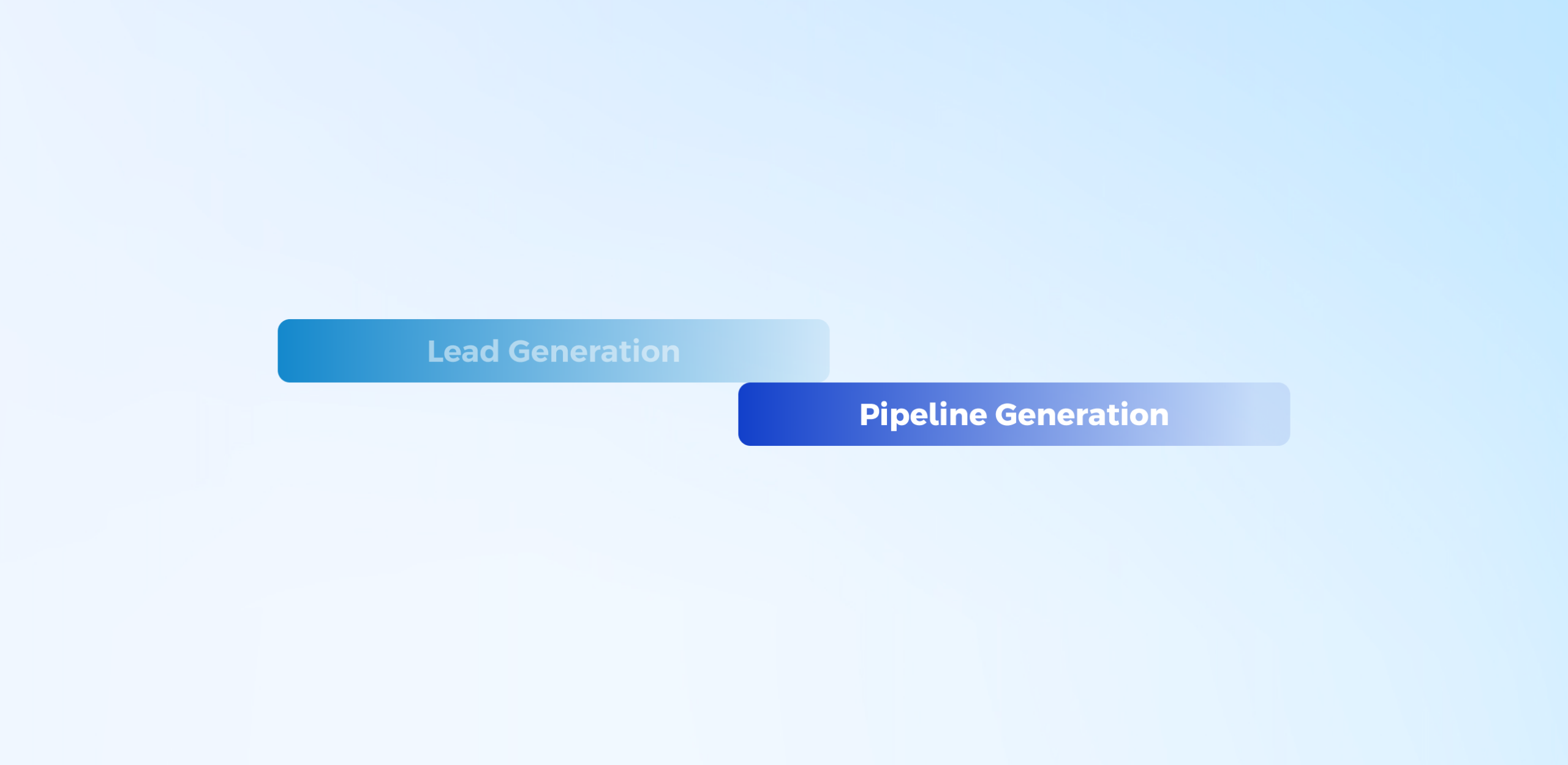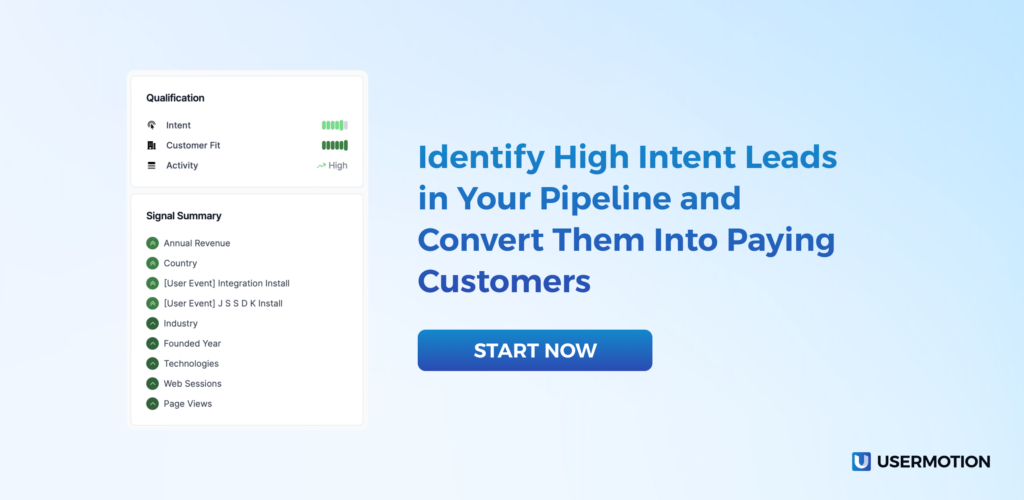All of us in the SaaS industry are familiar with pipelines and funnels. And we all follow proper sales funnels to acquire, adapt and convert leads into customers. However, pipelining focuses deeper into this process and instead of generating leads to place in the pipeline, it focuses on generating more leads in the pipeline. Let me explain what this is, how it works and how you can get the most out of it.
What is Pipeline Generation?
Pipeline generation is a strategy of creating a pipeline that acquire, adapt and convert buyers who are most interested in your product or service. This pipeline strategy is focused on creating a consistent flow that find and convert high-potential leads.
What is the Difference Between Pipeline Generation and Lead Generation?
The most visible difference between pipeline generation and lead generation is that pipeline generation focuses each stage of the sales funnel, converting users who have already shown interest in a product or service, while lead generation focuses on marketing and sales efforts and generate new leads.
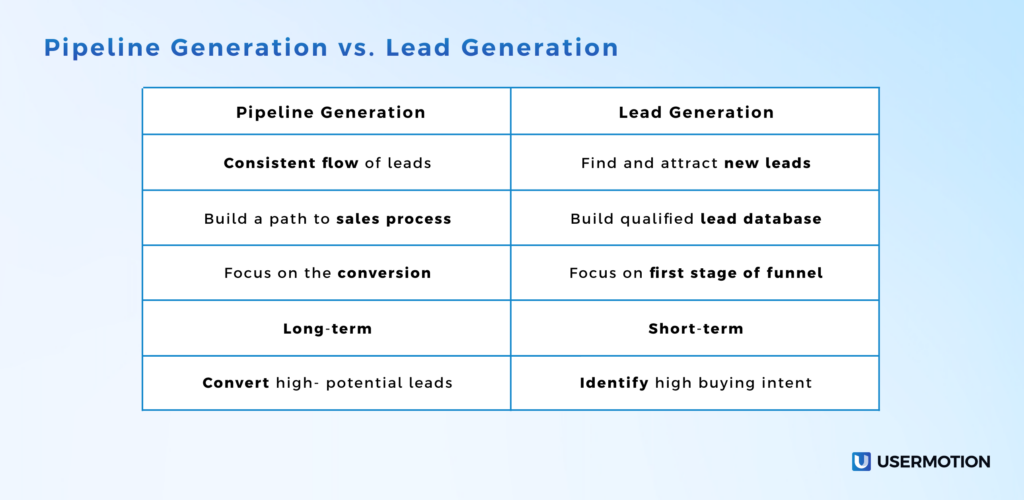
Lead generation highlights reaching a large audience to capture a high volume of leads. This approach prioritizes quantity over quality, aiming to build a large database of potential leads.
On the other hand, pipeline generation is emphasized on quality rather than quantity. It focuses on long-term strategies that create and maintain awareness among leads, guiding them through the sales process until they become customers.
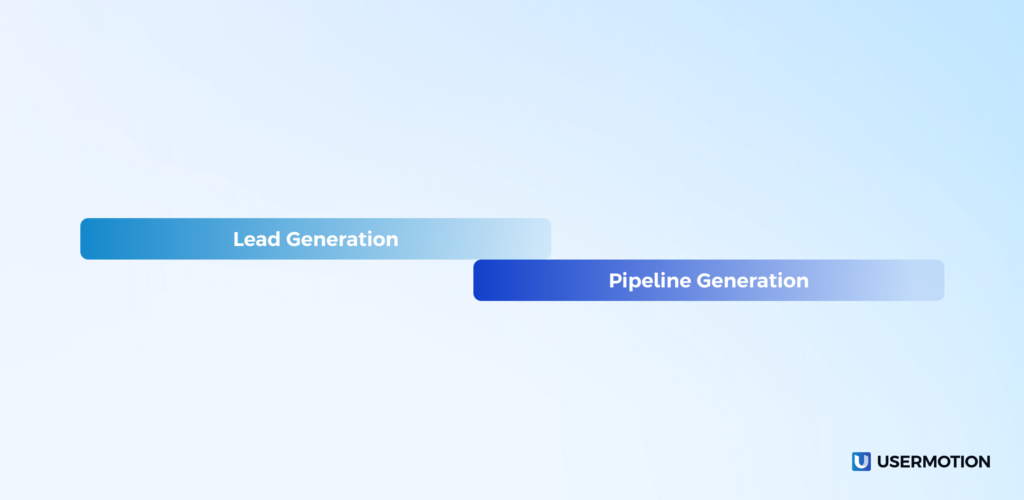
Pipeline sometimes generation meets with lead generation as it deals with leads that have already been acquired.
Lead Generation
Objective: To attract new leads by reaching a wide audience.
Stage in Sales Funnel: Primarily focuses on the top of the funnel, generating initial interest and awareness.
Timeframe: Short-term focus, aiming for immediate lead acquisition.
Lead Quality: Often targets individuals at the initial stage of interest, which may result in lower quality leads that need further qualification.
Pipeline Generation
Objective: To nurture and convert leads who have already shown interest.
Stage in Sales Funnel: Focuses on the whole funnel, aiming to convert leads into paying customers.
Timeframe: Long-term focus, with ongoing efforts to move leads through the sales process.
Lead Quality: Targets high-potential leads who are more likely to convert, resulting in higher quality leads.
Why You Need to Use Pipeline Generation?
It is about consistency and sustainable growth. Unlike lead generation, which focuses on attracting new leads, pipeline generation ensures that those leads are nurtured and guided through the entire sales process, ultimately converting them into loyal customers.
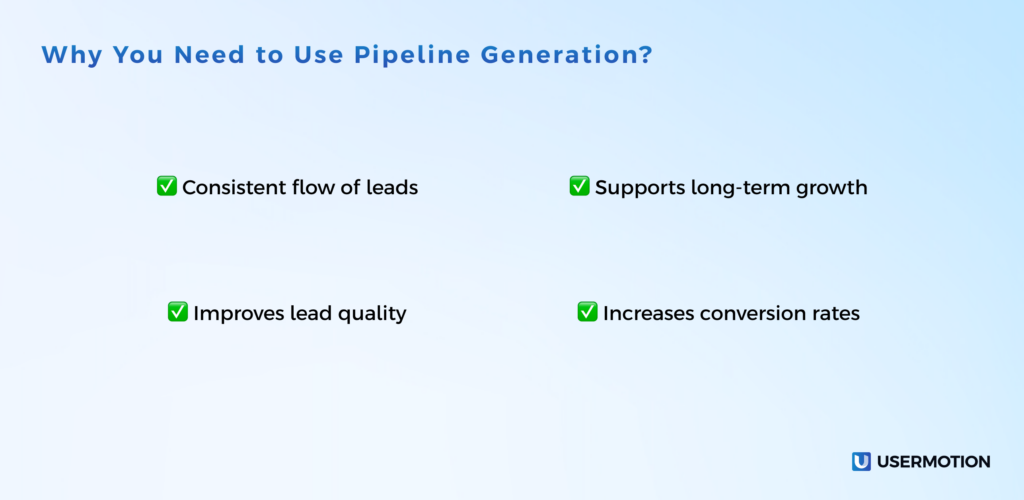
- Ensures a consistent flow of leads
- Improves lead quality
- Increases conversion rates
- Supports long-term growth
- Better sales forecasting
3 Blockers You Might Face with Pipeline Generation
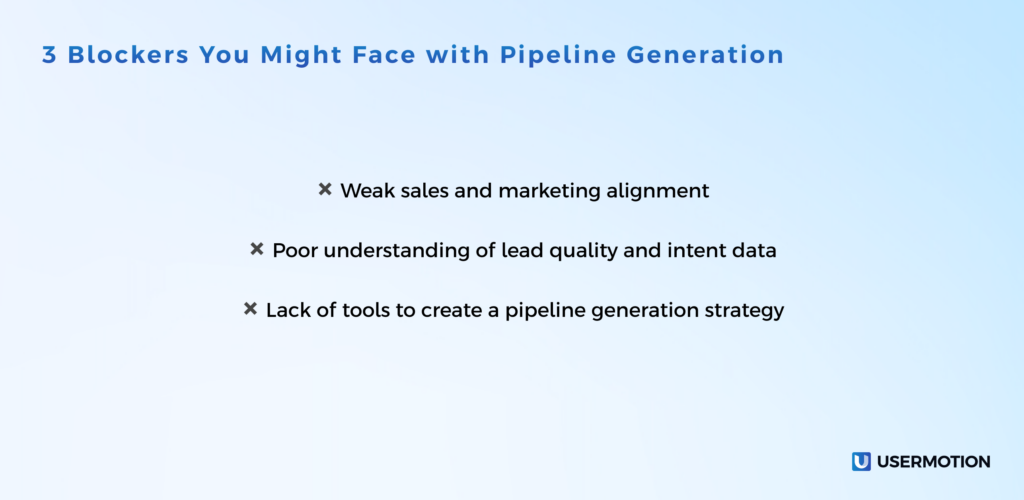
Pipeline generation is a strategy for sustained business growth, but it comes with its own set of challenges.
1. Weak sales and marketing alignment
A strong pipeline generation strategy requires seamless collaboration between sales and marketing teams. However, misalignment between these departments can lead to inefficiencies and missed opportunities.
Issues
- Different teams might present conflicting information to leads, leading to confusion and mistrust.
- Poor communication can result in leads falling through the cracks during the transition from marketing to sales.
- If sales and marketing have different objectives, it can lead to strategies that don’t complement each other, reducing overall effectiveness.
Solutions
- Schedule frequent meetings between sales and marketing to ensure everyone is on the same page.
- Align the goals and key performance indicators (KPIs) of both teams to ensure they are working towards the same objectives.
- Use integrated CRM and marketing automation tools.
2. Lack of tools to create a pipeline generation strategy
Without a proper set of tech tools, it can be challenging to track, nurture, and convert leads efficiently.
Issues
- Tracking the progress and status of leads through the sales funnel becomes difficult.
- The manual lead qualification process can be difficult to maintain.
- Lack of analytics and reporting tools can prevent you to gain insights.
Solutions
- Use a proper CRM system to manage and track leads throughout the sales funnel.
- Use marketing automation tools to streamline lead nurturing and communication processes.
- Invest in tools that provide detailed lead intent data and score your leads in your pipeline, like UserMotion.
UserMotion reveals intent of leads into your product or service, through different intent signals and ideal customer profile alignment, so you can improve your pipeline generation and conversion.
🥳 If you start now, ask our support agent for your 50% discount for 3 months.
3. Poor understanding of lead quality and intent data
As shared above, the quality and intent of your leads is really important for effective pipeline generation. Without this knowledge, you might waste resources on leads that are unlikely to convert.
Issues
- Focusing on leads with low buying intent can result in low conversion rates and wasted effort.
- Without clear insights into lead quality, your targeting and segmentation strategies may be less effective.
- Allocating resources to unqualified leads can drain your sales and marketing teams.
Solutions
- Implement lead scoring systems to rank leads based on their quality and likelihood to convert.
- Use tools and techniques to analyze intent data, helping you identify leads with a higher probability of conversion.
- Provide ongoing training for your sales and marketing teams to ensure they understand how to assess lead quality and interpret intent data effectively.
5 Pipeline Generation Strategies to Increase The Number of High-Potential Leads In Your Pipeline
Pipeline generation, as it focuses on the entire sales funnel and particularly the qualifying and converting stages, should be improved not by finding more leads but by revealing and converting the ones that are already present. High-quality pipeline generation focuses on two main aspects: identifying who is more ready to buy and understanding how they buy.
Here are five strategies to enhance your pipeline generation and increase the number of high-potential leads:
1. Identify your ideal customer profile
Understanding your ideal customer profile (ICP) is the foundation of effective pipeline generation. Knowing who your best customers are helps you target similar leads and customize your marketing and sales efforts to attract high-potential leads.
- Analyze your existing customer base to identify common characteristics among your best customers.
- Define demographic, geographic, psychographic, and behavioral traits of your ideal customers.
- Use this profile to guide your marketing and sales strategies, ensuring your efforts are focused on attracting leads that closely match your ICP.
2. Identify milestone events
Milestone events are significant occurrences that indicate a lead’s intent to move forward in the buying process. Identifying these events can help you prioritize high-potential leads.
- Track key events such as job changes, company expansions, or funding rounds that signal a higher likelihood of purchase.
- Identify customer behaviors and product usage patterns in your product that lead to buying.
- Use tools to monitor these events in real-time.
- Develop targeted campaigns to engage prospects when these milestone events occur, increasing the chances of conversion.
3. Quality the leads in your pipeline
To focus your efforts on high-potential prospects, it’s essential to qualify them effectively. This involves assessing their readiness to buy and their fit with your ICP.
- Implement a predictive lead scoring model that assigns points based on factors like engagement level, company size, and buying intent.
- Regularly review and update lead scores to reflect the most current information.
- Prioritize leads with higher scores for personalized follow-ups and targeted nurturing.
4. Invest in tools that help to fill your pipeline
The right tools can streamline your pipeline generation process and provide valuable insights into lead behavior and engagement. Investing in this kind of tools helps you efficiently manage and convert high-potential leads.
- Use CRM systems to track and manage leads throughout the sales funnel.
- Implement marketing automation tools to capture and nurture leads efficiently.
- Use intent data software to gain deeper insights into lead behavior and readiness to buy.
- Ensure these tools are integrated for seamless data flow and comprehensive visibility.
5. Establish a lead nurturing system
Consistent and personalized communication keeps leads engaged and moves them closer to a purchase decision. So, you need a well-designed strategy in nurturing your leads.
- Develop a content strategy that provides valuable information at each stage of the buyer’s journey.
- Use personalized email campaigns to deliver relevant content and offers based on lead behavior and preferences.
- Implement drip campaigns to maintain regular contact with leads, keeping your brand top of mind.
Pipeline Generation with UserMotion
Creating a consistent flow of high-potential leads and converting them into loyal customers is important. And it is what pipeline generation does. By focusing on the entire sales funnel, from identifying and engaging leads to nurturing and converting them, you can ensure sustainable growth and improved conversion rates.
UserMotion can significantly enhance your pipeline generation strategy by providing detailed intent data and insights into your leads’ behavior. This allows you to identify high-potential leads, understand their buying intent, and tailor your engagement strategies accordingly.
With UserMotion, you can:
- Reveal Intent: Understand the signals that indicate a lead’s readiness to buy.
- Align with Ideal Customer Profiles: Ensure your efforts are focused on leads that match your ideal customer profile.
- Enhance Lead Scoring: Implement a robust lead scoring system to prioritize high-potential leads.
- Streamline Pipeline Management: Use integrated tools to track and manage leads throughout the sales funnel.
Start improving your pipeline generation today with UserMotion. Contact us now to learn more and take advantage of our special offer: a 50% discount for the first three months. Let UserMotion help you transform your pipeline generation efforts and drive sustainable growth for your business.

